On The Solar (Ada)ptations
Intro
Solarpunk is a bit of an art movement, a bit of a genre, and a bit of speculative fantasy. It broadly envisions how the future might look like if society lived in harmony with nature in an egalitarian world. It’s the hope for the climate disaster that we got ourselves into and medicine to the climate anxiety. Renewable energy, handcrafts, lack of social hierarchy, focus on the communities, and localism – all of that and even more. Solarpunk is a sibling to Cyberpunk or Steampunk, but unlike these moody, dystopian, and mechanical universes, Solarpunk is a more optimistic, sustainable vision of the future.

Image by Luc Schuiten
The term “Solarpunk” has its roots on the internet in 2008. “Solar” should evoke light, both symbolic: the tone of narrative; and literal: the daylight in which life happens, as well as renewable energy. “Punk” term refers to anti-establishment, anti-capitalist, and anti-hierarchy, so in a way, it is rebelling against modern times. “Punk” also states for individuality, but rather of empowered communities, not individuals. Imagine solarpunk tribes that are basic social units. Solarpunk also emphasizes living in harmonic symbiosis with technology and embracing the low-carbon machinery that works for us, not the other way around. The solarpunk ethos states technology that blends into the environment and is powered by renewable energy. It is a literal part of the circular economy – one that eliminates waste through the continual use of resources.
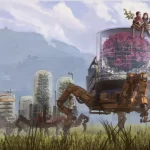
Image by Felix Riaño
Solarpunk’s aesthetic is heavily influenced by Art Nouveau and its use of organic, plant-based themes and gracious lines. What is interesting, Art Nouveau also has its roots in anti-capitalistic, anti-mass-production, and pro-crafts values. Mix this art movement with a significant portion of Retrofuturism and a small pinch of various strains of utopianism – and we get the visual style of Solarpunk. All the solarpunk designs, from architecture to fashion, should merge practicality with the beautiful. The design reflects diverse cultural origins, is homemade rather than mass-produced, and obviously made from recycled materials. In terms of colors, solarpunk adores natural hues, bright greens, floral palettes, and blues. Solarpunk-architecture is well established in concept art, and it’s been there even before the movement was created. In general, it radiates with ecological harmony. Buildings are covered in lush greenery, growing crops or trees on most surfaces to reduce carbon consumption through a combination of passive cooling, renewable energy, and locally-sourcing food. All architectural structures are constructed mainly from solar glass with translucent, stained-glass solar panels.
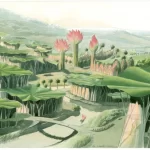
Image by Luc Schuiten
Ada(ptation)
How did I fall in love with Solar punk?
My entire life, I have been attracted to Art Nouveau. Its fluid shapes, nature integration, grace, and beauty in every form… It’s incredibly inspiring to me. In 2021, we even collaborated with Arthur Teboul on the font, Adaglossum, fully inspired by Art Nouveau. Though it’s not published yet, we wish to release it by the end of this year. I was also able to find a way to channel the themes of activism and environmental protection in my work. In 2019, I created the artwork “Gokotta: Bonding” for Wieden + Kennedy Amsterdam’s “Lost and not Found” exhibition supporting the Rainforest Trust’s SAVE challenge. The same year, I published the essay “On the NuDesign Sensibility” about the correlation between design and climate change.

Image by Ada Sokół
And then, in 2022, I discovered Solarpunk. It seems that unconsciously, with all my ecological interests and aesthetic preferences, I was driven to this movement.
Past, Present (my take)
Every day we are flooded with fatalistic predictions of the near future. Most of them, of course, seems to be inevitable. Humanity, as a whole, still values monetary gain over the well-being of future generations and the nature we conquered and dominated. Some, including me, still cling to the hope of a future in the spirit of the solar punk movement. It’s not too late to educate, reevaluate our actions and be the force of change.
A few years ago, I wanted to print my works on silk scarves. There is something appealing about those scarves – they can be worn on the body but also hung as an art object on the wall. Unfortunately, I abandoned the idea immediately after learning how silk is produced. Traditionally, silk is harvested by boiling the silkworm larvae alive in their cocoons to extract silk thread. I was amazed to discover that one of my heroines, Neri Oxman, explored this issue and found a simple solution for the ethical production of silk.

Image by Ada Sokół
Silk Pavilion I by Oxman Group
The Silk Pavilion is a stunning project that explores relationships between digital and biological construction, proposing methods that unite the biologically spun and the robotically woven. Inspired by the silkworm’s ability to generate a three-dimensional cocoon out of a single silk thread, Silk Pavilion was developed in 2013 and took the form of a three-meter wide dome constructed over three weeks with a flock of sixty-five hundred live silkworms. Each silkworm spun a single silk thread filament that was about 1km long. Together, the silkworms produced a dome-shaped thread as long as the Silk Road. By studying how spatial and environmental conditions inform the silkworm’s spinning behavior, the Oxman team has been able to guide the silkworm’s movement to spin two-dimensional sheets rather than three-dimensional cocoons. The base structure of the pavilion was created of polygonal panels made of silk threads laid down by a Computer-Numerically Controlled machine. Once established, a swarm of sixty five hundred silkworms was positioned at the bottom rim of the construction, where they began their work, spinning flat non-woven silk patches. The geometry of the pavilion was created using an algorithm that places a single continuous thread across patches providing various degrees of density. The overall density variation of the silk sheets was informed by the silkworm itself, deployed as a biological “printer” in the creation of this secondary structure. Due to their sensitivity to environmental conditions —geometrical density as well as variation in natural light and heat—the silkworms were found to migrate to darker and denser areas. With this in mind, Oxman’s team could calibrate variations in the thickness of the silk sheets to desired specifications. The most significant discovery of the project was that if the silkworm is placed on a flat surface, in nature, it might even be a tree trunk; the silkworm would create its cocoon in flat form and still successfully metamorphose into the moth. If only everyone in the industry was aware of this fact, the process of silk production could happen without the need to boil a single cocoon of a silkworm. This is a perfect example of not human-centric but a nature-centric fabrication.
Capsula Mundi
The consequences of our choices in life have an impact on Mother Nature even after our death. Are you familiar with more eco-conscious final farewell?
The biological life cycle and its transformations are the same for every living being. It is time for us to realize our integrated part in nature. Capsula Mundi wants to emphasize that we are a part of nature’s transformation cycle. This universal concept goes beyond cultural traditions. Only a tree, a symbol of the connection between the sky and the earth, marks the deceased’s resting place. As tree after tree is planted, the cemetery will become a forest, free of the architectural motifs marking today’s memorial grounds.

Image from Capsula Mundi website
Digiverse
Nowadays, almost every person lives in two parallel realities – physical and digital. We moved a huge chunk of our lives online. We work, play, shop, read, learn and love on the internet. A few years back, we started to gain awareness of the ecological impact of our increased usage of it.
NFT – terra0
Terra0 is a group of developers, theorists, and researchers exploring the creation of hybrid ecosystems in the technosphere, centered around decentralized technologies, founded in 2016. They created a stunning project called “Two Degrees NFT.” They minted a 20-second video of a scan of a small part of the German forest and made a smart contract that stores the average annual temperature rise as decided by NASA. When this value crosses the threshold of 2 degrees, the token can be burned by anyone who wants to call the smart contract function. Through this simple condition, the project addresses the relationship between global warming and the critical survival of the (eco)systems in an obvious way. Just as the real forest will disappear as soon as a certain threshold in global climate change is passed, so will the NFT. Moreover, the first project by Terra0 focuses on giving ownership to an augmented forest. The concept is that forest land ownership is structured as an AI DAO with smart contracts on the Ethereum blockchain. Using drones and satellites, the AI DAO can estimate the wood stock and decide how much and when to sell in the market. Once the project runs, the AI DAO can pay back the debts to its initial owners and eventually turn a forest into a self-determining, self-managed entity that controls its resources. How stunning is the idea? To give back the rights to mother nature, the rights that we took without permission.
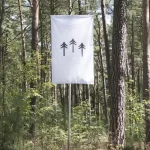
Image from terra0 website
Website – Adaversum
Almost 1.88 billion websites are currently available online. The more complex these websites are, the more energy they require to function, increasing their carbon footprint enormously. Sustainable, low-tech websites are still in the minority, but awareness about the environmental impact of traditional web design is slowly growing. To support this movement, we collaborated on one project with Digital Ecology Institute and designer Zofia Kofta. Low-tech websites are usually raw and bland in design. As an artist and visual designer, I think my website must also reflect my style. So, the goal was to design an energy-efficient, pixel-perfect, functional website. And it wasn’t easy. There are some limitations in terms of the design regarding ecological and sustainable choices.
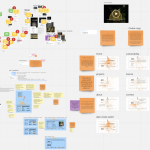
We had to let go of many conventional ideas, try multiple alternative options and learn a lot to fit into the environmental guidelines. We had to choose a system font to make web performance faster. All media had to be compressed, which was tough, as I admire seeing my works in extreme Hi-res. After careful analysis of the location, footprint of data storage, and transmission, we also chose a green hosting company. During our workflow, we only used open-source tools that are not so popular and developed but are ecologically friendly, like chat Wire or carbon-conscious web analytics Cabin, which also ensures data privacy. Everything to raise awareness about mindful usage of technology for the good of the environment. Another critical pillar of this project is feminism. All people involved in the project are women from Poland. It’s important to mark, as we hear mainly about male figures in the history of computer development and only a few female ones. Maybe that is why the internet lacks warmth and empathy.
All those aspects mentioned before created a unique digital ecosystem in the form of the website – called Adaversum.
Future
We need to educate the next generation to create a stunning, thoughtful future. The importance of sharing knowledge with protégés is enormous. Current views should also be updated based on their fresh and bold ideas. But modern education is based on rote memorization, and what if the foundations of schooling would be learning skills and values from life experience? Field trips and travels, exploring personal interests, work internships, etc. People would be encouraged to seek their accurate and most valuable interests and activities. And would it not be more sustainable?
That’s why we collaborated with Shiro Beta. He is a talented student from the Swiss university of art and design – Ecal, whom I had a chance to teach during my 3D workshops in 2021. This year, as an internship, we created a vision for the future based on the values mentioned before.
ProxyLifeforms
ProxyLifeforms is a speculative design project which seeks to explore the idea of a symbiotic relationship between AI and nature by amplifying the processes that nature has already perfected through centuries of evolution.
This project aims to explore the visual language of technology in relation to nature by creating an aesthetic language that simulates fractal processes, creating a possible future where technology lives seamlessly within nature, helping it recover from the impact of climate change.
Each “proxy” is a system composed of the AI and a mutualistic relationship with plants, algae, or bacteria, creating a sentient super-organism tasked with fighting environmental issues such as deforestation, water pollution, and rising temperatures.
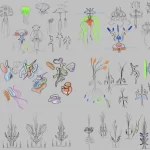
Image by Shiro Beta
The Plantae Proxy is an AI drone that hovers around wastelands seeking healthy specimens in areas suffering from deforestation. The AI communicates with the suitable candidate helping it with asexual reproduction, from which a sustainable clonal colony is formed.
Image by Shiro Beta
The Protista Proxy is an AI drone that inhabits oceans polluted by microplastics; it works with smart bacteria that break down microplastics and other pollutants in the ocean, as well as Algae that aid in the production of oxygen. By using a filtering system, this “proxy lifeform” constantly purifies water from micropollutants while also increasing oxygen production through an enhanced photosynthesis process carried out by the algae that grow inside the drone.


Image by Shiro Beta
To watch the animations and see them in higher quality, visit Shiro Beta’s Instagram: https://www.instagram.com/reel/CjnQRpijGdl/?utm_source=ig_web_copy_link
Outro
So what is the future? I will try to get as close as possible to solarpunk ideology as the current society will let me. Maybe someday, I will decide that it’s time to live as an outcast, out of this system. It is known that you can not LARP Solarpunk because acting it out would actually mean going out and planting a garden.
But for now, one of my deepest dreams is to create a sustainable art studio. Placed in the forest or other type of greenery, decked out with solar collectors, a water tank, and a glass roof,
with all PCs running on renewable energy and a team of compatible, art-focused individuals with one common goal: to create the most stunning, progressive projects.
It might seem impossible to do for some, but as Oscar Murillo once said:
“Is it possible to be a revolutionary and still like flowers?”
Sources:
- https://solarpunkcommunity.com/vision/education/, visit date, 20.08.2022
- Why Decentralized Artificial Intelligence Will Reinvent The Industry As We Know It, by Artur Kiulian, https://www.forbes.com/sites/forbestechcouncil/2017/11/16/why-decentralized-artificial-intelligence-will-reinvent-the-industry-as-we-know-it/?sh=485e1941511a, visit date: 22.08.2022
- Untangling the Tale of Ada Lovelace, by Stephen Wolfram, https://www.wired.com/2015/12/untangling-the-tale-of-ada-lovelace/, visit date: 29.08.2022
- Design Emergency: Building a Better Future, by Alice Rawsthorn and Paola Antonelli, published by Phaidon
- Building a Sustainable Internet: Ada Sokół on the eco-friendly, energy-efficient redesign of her website, in collaboration with Zofka Kofta and the Digital Ecology Institute, by Lena Manger, https://www.collide24.org/2022/06/23/3d/building-a-sustainable-internet-ada-sokol-on-the-eco-friendly-energy-efficient-redesign-of-her-website-in-collaboration-with-zofka-kofta-and-the-digital-ecology-institute/, visit date: 01.09.22
- What is solarpunk and can it help save the planet?, By Nicola K Smith, https://www.bbc.com/news/business-57761297, visit date: 05.09.2022
- Solarpunk Is Not About Pretty Aesthetics. It’s About the End of Capitalism, by Hannah Steinkopf-Frank, https://www.vice.com/en/article/wx5aym/solarpunk-is-not-about-pretty-aesthetics-its-about-the-end-of-capitalism, visit date: 06.09.2022
- The ‘Vegetal’ Cities of Luc Schuiten: A Sustainability Fantasy, by John Metcalfe, https://www.bloomberg.com/news/articles/2012-09-10/the-vegetal-cities-of-luc-schuiten-a-sustainability-fantasy, visit date: 06.09.2022
- As environmental catastrophe unfolds, we need architecture that is more than just green, by Darran Anderson, https://www.dezeen.com/2019/01/23/darran-anderson-opinion-modular-adaptive-architecture-environment-anthropocene/, visit date: 21.09.2022
- https://www.capsulamundi.it/en/project/, visit date 21.09.2022
- https://oxman.com/projects/silk-pavilion-i


